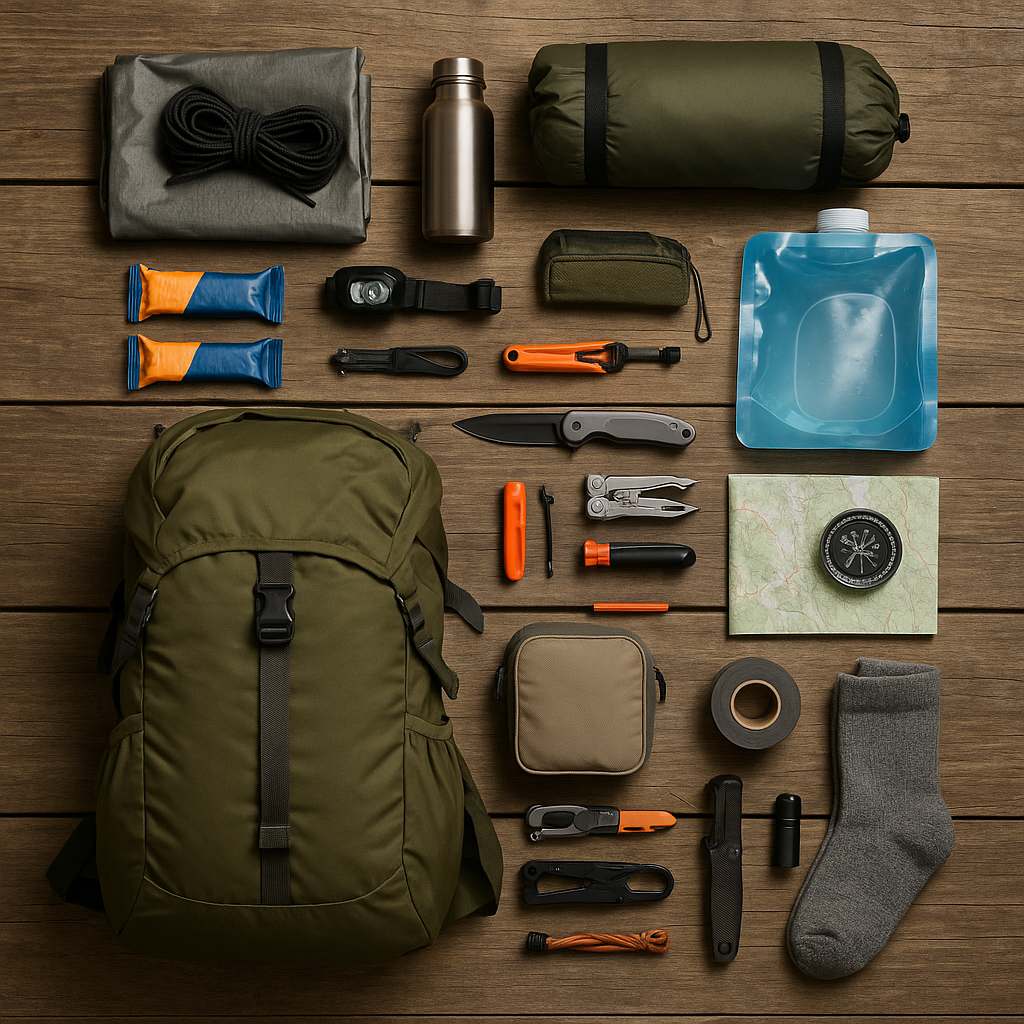Speed. Mobility. Survival.
In an emergency, the weight of your gear can either help you escape... or hold you back. A lightweight bug-out bag is designed to give you just enough to survive 72 hours, without sacrificing agility or endurance. This isn’t about being comfortable—it’s about staying alive and staying on the move.
Here’s how to pack smart, efficiently, and light.
---
1. Shelter & Sleep: Protect Your Core
Tarp or Bivy Instead of a Tent
A tent is heavy, slow to pack, and often more than you need. A quality tarp or bivy sack gives you fast, flexible shelter from wind and rain. It also lets you blend into your environment more easily, which is ideal for stealth or tactical bug-outs.
Emergency Blanket
A Mylar blanket reflects 90% of your body heat. It's lightweight and cheap and can double as a signal mirror, rain catcher, or even a fire reflector.
Compact Sleeping Setup
Look for ultralight sleeping bags or quilts designed for backpackers. If you're in a mild climate, a liner or wool blanket might be enough. Insulation underneath you is just as important; carry a foam pad if weight allows.
---
2. Water & Hydration: Purify, Store, Survive
Water Purification Tools
Clean water is your #1 priority! Carry a LifeStraw or Sawyer Mini for fast access, and backup tablets or iodine for long-term safety.
Collapsible Water Containers
Space-saving and feather-light when empty. You’ll want at least 2 liters of water capacity at any given time.
Hydration Bladder (Optional)
Useful for hands-free hydration, especially if you're on foot and covering distance. Just remember: bladders are harder to refill and clean in the field.
Backup Bottles
A single 1L bottle (like Nalgene or SmartWater) is rugged and useful for boiling, mixing, or measuring.
---
3. Food: Pack Calories, Not Cans
High-Calorie, Low-Bulk Foods
Energy bars, peanut butter packets, trail mix, jerky, and freeze-dried meals give you the calories you need without weight or prep. Aim for 2,000+ calories per day per person.
Cooking System (Optional)
If you have time or want warm food, carry a small backpacking stove and fuel canister. A titanium cup or pot gives you the ability to boil water, which is essential for both food and sterilization.
---
4. First Aid & Hygiene: Stay Functional
First Aid Essentials
Injuries are more likely when you’re exhausted, cold, or moving fast. Include gauze, antiseptic, bandages, tweezers, and medical tape. Know how to use everything you pack.
Critical Meds
Your prescriptions, allergy meds, and pain relievers should be packed airtight and waterproof.
Hygiene for Health
A small toothbrush, mini toothpaste, bar soap slice, and travel wipes can prevent infection and disease—don’t overlook this category. Add feminine hygiene if needed.
---
5. Navigation & Tools: Know Your Way Out
Map & Compass
GPS is great—until it fails. Learn to read a topographic map and use a compass. This alone can save your life.
Lighting Tools
A headlamp is more useful than a flashlight because it keeps your hands free. Pack extra batteries or choose a solar/rechargeable version.
Multi-Tool
Choose one with pliers, a blade, a screwdriver, scissors, and a can opener. This saves space by replacing five tools.
Signal Whistle
Small and loud. Use it for rescue, communication, or to scare off threats.
---
6. Clothing & Personal Gear: Layer Smart
Moisture-Wicking Clothing
Wet = cold. Cold = dead. Merino wool or synthetic fabrics keep you warm even when wet, and they dry quickly. Avoid cotton.
Extra Socks
Your feet are your engine. Keep them dry and protected to prevent trench foot or blisters.
Sun Protection
A brimmed hat, polarized sunglasses, and sunscreen prevent sunburn, dehydration, and exhaustion.
Emergency Cash
ATMs might be down. A small stash of small bills can help you barter, pay for fuel, or bribe your way through checkpoints.
---
7. Multipurpose Tools: Maximum Utility
Duct Tape
Wrap a few feet around your lighter or water bottle. Use for repairs, blisters, patches, and even first aid.
Paracord
550 cord is light, strong, and has endless survival uses—from shelter building to fishing line to makeshift belts.
Fire Starting
Carry at least three methods: a Bic lighter, waterproof matches, and a ferro rod. Fire is survival; don’t risk going without it.
---
8. Pack Strategy: Balance & Fit
Choose the Right Pack
Look for an internal frame backpack under 50L. It should fit your torso size, distribute weight well, and have padded straps for comfort.
Pack Heavy Items Low and Center
Heavier items (water, stove, etc.) should ride low and close to your spine for balance and mobility. Keep essentials near the top or in side pockets.
---
9. Practice Makes Prepared
Test Everything
Set up your shelter. Light a fire in the rain. Purify water from a ditch. Don’t wait until you need your gear to learn how to use it.
Refine, Replace, Repack
Your environment, health, and skills change—so should your bag. Review it seasonally, after drills, or after each outing.
---
Final Thoughts: Don’t Just Pack It—Know It
A bug-out bag is more than gear. It’s your lifeline. Your escape plan. Your last resort when everything else fails. Whether you're leaving ahead of a storm or walking away from a collapsing grid, your kit should be lightweight, tested, and tailored to your survival, not someone else’s.
Start with the essentials. Drop the rest. And remember: the less you carry, the farther you go.
As I said before, as you use the bag, learn more about it and learn what works for you and what doesn't work. Take notes of your pack and update it as you learn more about it. The more field-tested your bug-out bag is, the better it will serve you.
Liability
Educational Use Only: The techniques, drills, and scenarios presented here are offered “as-is” for informational purposes. Wilderness travel, emergency response, and survival training carry inherent risks—including severe injury or death. By reading, viewing, or implementing any material from this site, you accept full responsibility for your actions and agree that the author bears no liability whatsoever for any loss, harm, or legal consequences that may result. Always seek qualified instruction, obey local laws, and exercise prudent judgment.


